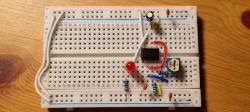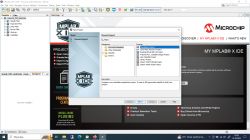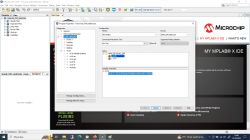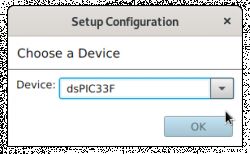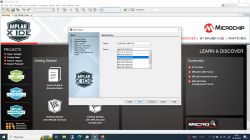FAQ
TL;DR: Inverter converts 230 V single-phase to 3 × 230 V, drives ≈ 400 W loads; parts bill ≈ PLN 200 (€43) [Elektroda, Tatalek, post #18953875] “The inverter has high temperature protection set at 105 °C” [Elektroda, Tatalek, post #18953619] Space-Vector Modulation yields ~15 % higher phase voltage than SPWM [Elektroda, Tatalek, post #18953619]
Why it matters: DIY builders can match commercial 0.4 kW VFD performance while learning modern PFC and SVM techniques.
Quick Facts
• Power stage: FNA41560 IPM, 600 V/15 A IGBT bridge [Elektroda, Tatalek, post #18953619]
• Input PFC: Boosts DC bus to 430 V no-load, 400 V @ 400 W [Elektroda, Tatalek, post #18953619]
• Output frequency: 1–80 Hz, 0.1 Hz resolution; useful above 5 Hz [Elektroda, Tatalek, post #18953619]
• Switching frequency: 5 kHz, 1.2 µs dead-time optimized for IPM [Elektroda, Tatalek, post #18953619]
• Protections: 105 °C over-temp, 5 A cycle-by-cycle short, 460 V over-voltage [Elektroda, Tatalek, post #18953619]
Will this inverter run a 20 000 rpm electro-spindle?
No. A 20 k rpm spindle needs ≈ 400 Hz supply (4-pole motor) [Elektroda, VaM VampirE, post #18953966] The inverter’s top frequency is 80 Hz [Elektroda, Tatalek, post #18953619], so it cannot reach the required speed.
What parts drive the cost to PLN 200?
Electrolytic filter capacitors and the PFC choke account for ≈ PLN 70; the remaining PLN 130 covers the IPM, MCU, passives, PCB and connectors [Elektroda, Tatalek, post #18953875]
Which choke is used and was it hand-wound?
A ready-made DTMSS-47/0.22/15-V ferrite choke is used; only three extra turns were added for MC33262 power [Elektroda, Tatalek, post #18953875]
Can I replace MC33262 with cheaper L6562 in the PFC?
Yes, both are average-current boost PFC controllers; component values must be recalculated because L6562 uses different sense/zero-current thresholds [ST, 2018 ‘AN5193’]. Ensure gate-drive rating suits your MOSFET.
Why did the motor buzz at low speed and how was it fixed?
Noise came from a DC component caused by false FLT triggers; adding a 1.5 nF capacitor from FLT to ground eliminated the glitch [Elektroda, Tatalek, post #18956999]
Is the design safe for continuous speed control of an induction motor?
Yes within ratings. It offers U/f compensation above 5 Hz and thermal, over-current and over-voltage protections [Elektroda, Tatalek, post #18953619] Avoid running below 5 Hz for long; cooling airflow is low and torque drops.
How do I start the board without damaging D11?
- Solder PFC parts and add two 100 W/230 V bulbs in series across the DC bus.
- Power through two NTC6D-15 thermistors to limit inrush.
- Verify ≈ 400 V across capacitors before adding the IPM. [Elektroda, Tatalek, post #18953619]
What happens if FLT stays low during programming?
FVO pin pulls low when Vcc < 12 V, lighting the fault LED and disabling PWM. Remove programmer power and apply 15 V to the IPM to clear the fault [Elektroda, Tatalek, post #18953619]
Can this inverter be adapted to FSAM20SM60A modules from air-conditioners?
Yes. FSAM20SM60A uses active-low gate signals; invert the MCU’s PWM outputs in code or with inverters before feeding the module [Elektroda, Tatalek, post #20735214]
What extra statistic shows performance under load?
DC bus sag is 7 %: 430 V open-circuit versus 400 V at full 400 W load [Elektroda, Tatalek, post #18953619]
Edge-case: what failure can destroy the PFC diode?
Directly connecting the board to mains without inrush limiting can over-stress diode D11 and capacitors, leading to immediate failure [Elektroda, Tatalek, post #18953619]
Which programmer and MPLAB version support dsPIC33FJ32MC102?
Pickit 3 or SNAP program the device. MPLAB X IDE ≥ v5.35 lists the MCU; install XC16 compiler and the dsPIC33F GP/MC Device Pack to resolve DFP errors [Elektroda, Tatalek, post #20775312]
How low can I slow an induction motor?
With constant voltage below 5 Hz, torque falls sharply. Practical minimum speed is about 10 % of nominal while maintaining cooling and avoiding stall [NEMA MG1-2018].
Expert tip for quieter output?
“Spread-spectrum PWM smears switching noise into white noise and is less annoying to the ear” [Elektroda, Bojleros, post #18992697]
What’s the benefit of SVM over sine PWM here?
SVM raises maximum phase-to-phase voltage from 0.866·Vdc to nearly Vdc, adding ~15 % headroom without higher bus voltage [Elektroda, Tatalek, post #18953619]




